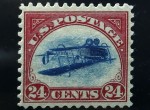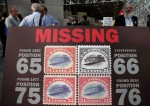 An Inverted Jenny stamp that was stolen 61 years ago has been found and returned to its owner. The stamp, beloved by collectors for its mistakenly upside-down biplane, was consigned to New York auctioneer Spink USA by Keelin O’Neill of Northern Ireland. O’Neill got the stamp in October of 2013 from his late grandfather who he believed bought it at a garage sale. He had no idea of its value until recently when he did a little Google snooping and realized he might have a winning lottery ticket in stamp form.
An Inverted Jenny stamp that was stolen 61 years ago has been found and returned to its owner. The stamp, beloved by collectors for its mistakenly upside-down biplane, was consigned to New York auctioneer Spink USA by Keelin O’Neill of Northern Ireland. O’Neill got the stamp in October of 2013 from his late grandfather who he believed bought it at a garage sale. He had no idea of its value until recently when he did a little Google snooping and realized he might have a winning lottery ticket in stamp form.
 At first the Spink appraiser thought it had to be fake, so he had it authenticated by the Philatelic Foundation in New York. There it was recognized as one of the block of four Inverted Jennies stolen in 1955. They notified the FBI and the owner, the American Philatelic Research Library (APRL). When he learned the stamp was stolen, O’Neill agreed to give it back to the APRL. He didn’t hit the jackpot he would have had the stamp been legitimately his — another Inverted Jenny, position 58, sold last Tuesday at auction for $1.175 million including buyer’s premium — but he wasn’t left empty-handed. O’Neill got a $10,000 reward from the American Philatelic Research Library and was just in the nick of time to collect a $50,000 reward offered by Donald Sundman of Mystic Stamp which was set to expire Saturday.
At first the Spink appraiser thought it had to be fake, so he had it authenticated by the Philatelic Foundation in New York. There it was recognized as one of the block of four Inverted Jennies stolen in 1955. They notified the FBI and the owner, the American Philatelic Research Library (APRL). When he learned the stamp was stolen, O’Neill agreed to give it back to the APRL. He didn’t hit the jackpot he would have had the stamp been legitimately his — another Inverted Jenny, position 58, sold last Tuesday at auction for $1.175 million including buyer’s premium — but he wasn’t left empty-handed. O’Neill got a $10,000 reward from the American Philatelic Research Library and was just in the nick of time to collect a $50,000 reward offered by Donald Sundman of Mystic Stamp which was set to expire Saturday.
The Inverted Jenny was coveted by collectors before it was even sold. The US Post Office created the stamp to coincide with the launch of the first regular airmail routes on May 15th, 1918, in Washington, D.C., New York and Philadelphia. A fleet of six modified (the co-pilot seat was removed to make space for more mailbags) Curtiss JN-4H biplanes would transport the mail. Flying was a more expensive proposition so the three-cent stamps of standard first-class mail wouldn’t cut it. The price of an airmail stamp was set to a whopping 24 cents, and the first series of stamps would celebrate the new medium by featuring the Curtiss JN-4H in blue against a carmine rose frame for a patriotic red-white-and-blue color scheme.
 This was a very last-minute operation. The engraving began on May 4th, printing on May 10th. The first deliveries reached post offices in D.C., New York and Philly on May 13th and the stamps went on sale May 14th, just under the wire for the inaugural airmail flight from Washington, D.C. the next day. Collectors were on high alert already, knowing that this speedy print run was susceptible to inverts. At least three sheets with upside-down biplanes were spotted by inspectors and destroyed. A single sheet of 100 stamps managed to slip through quality control and into history.
This was a very last-minute operation. The engraving began on May 4th, printing on May 10th. The first deliveries reached post offices in D.C., New York and Philly on May 13th and the stamps went on sale May 14th, just under the wire for the inaugural airmail flight from Washington, D.C. the next day. Collectors were on high alert already, knowing that this speedy print run was susceptible to inverts. At least three sheets with upside-down biplanes were spotted by inspectors and destroyed. A single sheet of 100 stamps managed to slip through quality control and into history.
Collector William T. Robey hit the philatelic lottery when he bought that sheet at the New York Avenue Post Office in Washington, D.C. on May 14th, 1918. He bought it for face value, of course: $24. Robey spread the news of his score to other collectors and the media and within a week he was assailed by all manner of folks clamoring to buy it, not to mention several postal inspectors who wanted the error sheet back. He sold it to Philadelphia stamp dealer Eugene Klein for $15,000. By the end of the month, Klein had sold it collector Colonel Edward H.R. Green for $20,000. It was Green who broke up the sheet. He had Klein divvy it all up into single stamps and small blocks. They wrote a number in light pencil on the back of each stamp so they could be identified by their original positions on the sheet. Those numbers are still in use today. Green kept a few blocks and sold the rest.
 One of those blocks — positions 65, 66, 75, 76 — was acquired in 1936 for $16,000 by philatelist Ethel Bergstresser McCoy, daughter of Charles M. Bergstresser, silent partner and co-founder of Dow Jones & Company. McCoy was one of very few women to break into the old boys’ club that was philately at that time. She was widely respected as an expert in the field and had a particular interest in stamps with airplanes and palm trees. The McCoy block of Inverted Jennies was on display at a convention of the American Philatelic Society in Norfolk, Virginia, in 1955 when it was stolen by person or persons unknown.
One of those blocks — positions 65, 66, 75, 76 — was acquired in 1936 for $16,000 by philatelist Ethel Bergstresser McCoy, daughter of Charles M. Bergstresser, silent partner and co-founder of Dow Jones & Company. McCoy was one of very few women to break into the old boys’ club that was philately at that time. She was widely respected as an expert in the field and had a particular interest in stamps with airplanes and palm trees. The McCoy block of Inverted Jennies was on display at a convention of the American Philatelic Society in Norfolk, Virginia, in 1955 when it was stolen by person or persons unknown.
Before her death in 1980, Ethel McCoy signed an agreement assigning all title to the stamp block to the American Philatelic Research Library. The FBI recovered the position 75 (lower left of the block) stamp in 1977 and position 65 in 1982. They were both in the hands of Chicago dealers and had been altered to make them less recognizable as McCoy block stamps. Now the first of the stamps on the right side has been recovered, leaving only position 66 still missing.
Being a non-native speaker, and under normal circumstances lacking any particular interest in stamps, I often wondered what ‘late’, e.g. in context with a ‘late grandfather’ is supposed to mean – is its intended meaning to express ‘short before his death’ or ‘now dead’ ?
In other words, does “You’re getting late, Grampa” leave room for interpretation ? Is there also something like an ‘early grandfather’ – for instance, soon after my own birth ?
😆 It means now dead. It’s an indicator that the person you’re talking about, who was living when he did/said what you’re talking about, is no longer alive. I used it in this case as shorthand to explain why he can’t answer any questions about how he got his hands on a stolen Inverted Jenny.
“just in the nick of time to collect a $50,000 reward offered by Donald Sundman of Mystic Stamp which was set to expire Saturday”: my, how I laughed. Luck of the Irish, eh?
Yeah, what a coincidence gramps’s garage sale find was turned in just in the nick o’ time to pocket the reward.
From the Chicago Tribune January 13, 1985
By Les Winick:
The Federal Bureau of Investigation recently announced the largest recovery of rare postage stamps in U.S. history. The stamps were stolen from the New York Public Library on May 9, 1977, and have an estimated value of $500,000.
The collection was donated to the library in 1925 by Benjamin K. Miller, a Minneapolis lawyer. Not all of the collection was on display at the time of the burglary. Among the stamps taken was the famous 24-cent air mail invert with the picture of the Curtiss-Wright “Jenny“ biplane printed upside down by mistake. This stamp is valued at $150,000.
Even so, in ‘nick of time’, at the handover ceremony, Mr. O’Neill looks kinda bummed.